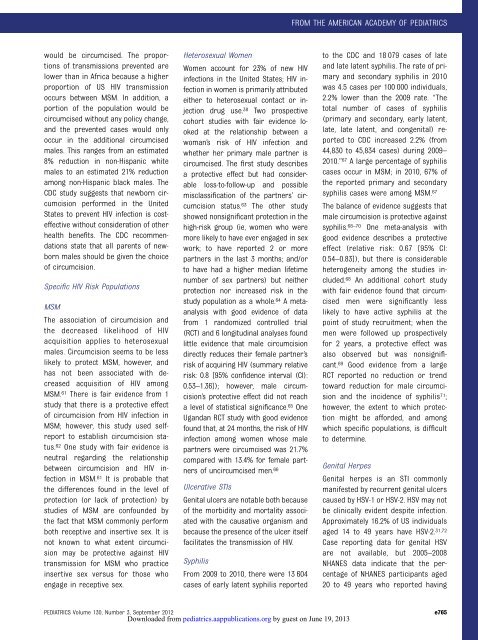Notat om omskæring af drenge - Sundhedsstyrelsen
Notat om omskæring af drenge - Sundhedsstyrelsen
Notat om omskæring af drenge - Sundhedsstyrelsen
- No tags were found...
Create successful ePaper yourself
Turn your PDF publications into a flip-book with our unique Google optimized e-Paper software.
FROM THE AMERICAN ACADEMY OF PEDIATRICSwould be circumcised. The proportionsof transmissions prevented arelower than in Africa because a higherproportion of US HIV transmissionoccurs between MSM. In addition, aportion of the population would becircumcised without any policy change,and the prevented cases would onlyoccur in the additional circumcisedmales. This ranges fr<strong>om</strong> an estimated8% reduction in non-Hispanic whitemalestoanestimated21%reductionamong non-Hispanic black males. TheCDC study suggests that newborn circumcisionperformed in the UnitedStates to prevent HIV infection is costeffectivewithout consideration of otherhealth benefits. The CDC rec<strong>om</strong>mendationsstate that all parents of newbornmales should be given the choiceof circumcision.Specific HIV Risk PopulationsMSMThe association of circumcision andthe decreased likelihood of HIVacquisition applies to heterosexualmales. Circumcision seems to be lesslikely to protect MSM, however, andhas not been associated with decreasedacquisition of HIV amongMSM. 61 There is fair evidence fr<strong>om</strong> 1study that there is a protective effectof circumcision fr<strong>om</strong> HIV infection inMSM; however, this study used selfreportto establish circumcision status.62 One study with fair evidence isneutral regarding the relationshipbetween circumcision and HIV infectionin MSM. 61 It is probable thatthe differences found in the level ofprotection (or lack of protection) bystudies of MSM are confounded bythe fact that MSM c<strong>om</strong>monly performboth receptive and insertive sex. It isnot known to what extent circumcisionmay be protective against HIVtransmission for MSM who practiceinsertive sex versus for those whoengage in receptive sex.Heterosexual W<strong>om</strong>enW<strong>om</strong>en account for 23% of new HIVinfections in the United States; HIV infectionin w<strong>om</strong>en is primarily attributedeither to heterosexual contact or injectiondrug use. 38 Two prospectivecohort studies with fair evidence lookedat the relationship between aw<strong>om</strong>an’s risk of HIV infection andwhether her primary male partner iscircumcised. The first study describesa protective effect but had considerableloss-to-follow-up and possiblemisclassification of the partners’ circumcisionstatus. 63 The other studyshowed nonsignificant protection in thehigh-risk group (ie, w<strong>om</strong>en who weremore likely to have ever engaged in sexwork; to have reported 2 or morepartners in the last 3 months; and/orto have had a higher median lifetimenumber of sex partners) but neitherprotection nor increased risk in thestudy population as a whole. 64 Ametaanalysiswith good evidence of dat<strong>af</strong>r<strong>om</strong> 1 rand<strong>om</strong>ized controlled trial(RCT) and 6 longitudinal analyses foundlittle evidence that male circumcisiondirectly reduces their female partner’srisk of acquiring HIV (summary relativerisk: 0.8 [95% confidence interval (CI):0.53–1.36]); however, male circumcision’sprotective effect did not reacha level of statistical significance. 65 OneUgandan RCT study with good evidencefound that, at 24 months, the risk of HIVinfection among w<strong>om</strong>en whose malepartners were circumcised was 21.7%c<strong>om</strong>pared with 13.4% for female partnersof uncircumcised men. 66Ulcerative STIsGenital ulcers are notable both becauseof the morbidity and mortality associatedwith the causative organism andbecause the presence of the ulcer itselffacilitates the transmission of HIV.SyphilisFr<strong>om</strong> 2009 to 2010, there were 13 604cases of early latent syphilis reportedto the CDC and 18 079 cases of lateand late latent syphilis. The rate of primaryand secondary syphilis in 2010was 4.5 cases per 100 000 individuals,2.2% lower than the 2009 rate. “Thetotal number of cases of syphilis(primary and secondary, early latent,late, late latent, and congenital) reportedto CDC increased 2.2% (fr<strong>om</strong>44,830 to 45,834 cases) during 2009–2010.” 67 A large percentage of syphiliscases occur in MSM; in 2010, 67% ofthe reported primary and secondarysyphilis cases were among MSM. 67The balance of evidence suggests thatmale circumcision is protective againstsyphilis. 68–70 One meta-analysis withgood evidence describes a protectiveeffect (relative risk: 0.67 [95% CI:0.54–0.83]), but there is considerableheterogeneity among the studies included.68 An additional cohort studywith fair evidence found that circumcisedmen were significantly lesslikely to have active syphilis at thepoint of study recruitment; when themen were followed up prospectivelyfor 2 years, a protective effect wasalso observed but was nonsignificant.69 Good evidence fr<strong>om</strong> a largeRCT reported no reduction or trendtoward reduction for male circumcisionand the incidence of syphilis 71 ;however, the extent to which protectionmight be <strong>af</strong>forded, and amongwhich specific populations, is difficultto determine.Genital HerpesGenital herpes is an STI c<strong>om</strong>monlymanifested by recurrent genital ulcerscaused by HSV-1 or HSV-2. HSV may notbe clinically evident despite infection.Approximately 16.2% of US individualsaged 14 to 49 years have HSV-2. 31,72Case reporting data for genital HSVare not available, but 2005–2008NHANES data indicate that the percentageof NHANES participants aged20 to 49 years who reported havingPEDIATRICS Volume 130, Number 3, September 2012Downloaded fr<strong>om</strong> pediatrics.aappublications.org by guest on June 19, 2013e765

















